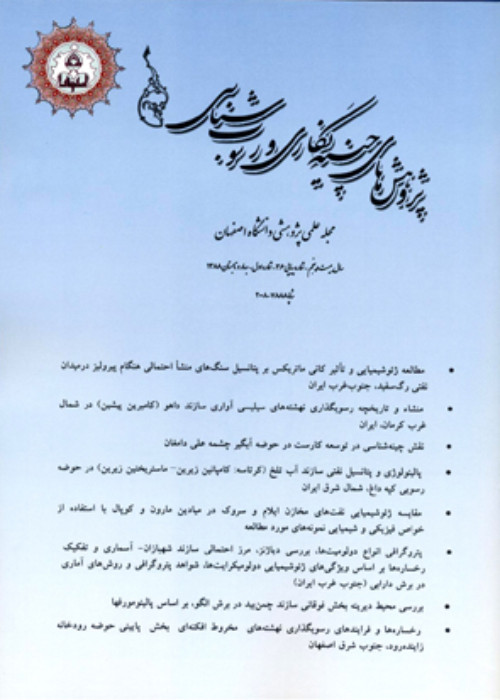Depositional environment of Jurassic deposits in the Binalud basin, according to the provenance and paleo-tectonic setting, northwest of Mashhad, Iran
Author(s):
Article Type:
Research/Original Article (دارای رتبه معتبر)
Abstract:
Abstract
The thick Jurassic fluvial coarse-grained sediments rest non-conformably on older metamorphic rocks to the northwest of Mashhad. Two sections, 300 and 400 m thick, were measured and studied through the Jurassic deposits. In this unit, three facies assemblages, conglomerate, sandstone and shale, have been identified. They comprise eight lithofacies (Gcm, Gmg, Gmm, Sm, Sh, Sp, Fl, and Fm) and four architectural elements (Channel-fill element (CH), Sediment gravity flows (SG), Downstream–accretion element (DA), and Overbank fines (FF)). The orientation of the gravel particles indicates that the direction of the paleo-flow was from northeast to southwest. The presence of an erosive base, lens-shaped sediment bodies, and fining-upward sequences suggests a gravelly braided-river system that deposited in a half-graben. Based on the results of petrological studies, subarkose, arkose, lithic arkose, sublitharenite, and litharenite are the main identified sandstone petrofacies. Also, based on the components of the sandstones, plutonic and metamorphic rocks have been identified as the source of sediments deposited in a humid climatic condition. In addition, the grain types suggest recycled orogen (RO), craton interior (CI), dissected arc (DA), and transitional continental (TC) tectonic settings of the study area during deposition.
Keywords: Conglomerate, Braided river, Paleotethys, Jurassic, Binalud, Iran
Material &
Discussion of Results &
The lack of any marine fossils and the abundance of plant fossils in the finer-grained parts clearly point to a non-marine setting. The conglomerates and pebbly sandstones can be interpreted as the fills of braided river channels in an alluvial fan system (Wilmsen et al. 2009a; Poursoltani et al. 2015, Poursoltani and Fursich 2020). Medium to coarse-grained sandstones with planar lamination and occasional trough cross-stratification can be interpreted as part of fluvial channel fills deposited during times of waning flow velocity. Fine to very fine-grained sandstones, some with plant fragments, interbedded with siltstones and mudstones represent overbank sediments. The mudstones and shales are floodplain deposits.
Petrographically, the sandstones are fine to medium-grained and grain-supported, with some coarse-grained and well-rounded components. Based on Folk’s classification (1980), the sandstones are predominantly subarkose, arkose, lithic arkose, sublitharenite, and litharenite. Based on the petrographic analysis of the Jurassic sandstones, plotted on the diagrams of Dickinson et al. (1983) and Yerino and Maynard (1984), craton interior, recycled orogen, quartzose recycled, mixed zone, and transitional continental are the main tectonic settings of the studied sediments. Basu’s diagram (Basu et al., 1985, with Qp, Qm u, Qm, nu) indicates that metamorphic rocks were the main source area of the deposits. In the Q–F–R ternary diagram of Suttner et al. (1981), the Jurassic sandstones plot in the field for plutonic and metamorphic source areas under humid climate conditions.
According to previous studies (Wilmsen et al., 2009a; Sheikholeslami and Kouhpeyma 2012) and the result of this study, the non-marine Jurassic succession was possibly related to the early Middle Jurassic Mid-Cimmerian Tectonic Event. Thus, we suggest that the Jurassic strata of the Binalud Mountains were deposited in a half-graben. This graben formed within the Cimmerian mountain belt and developed during a late phase of the Early Cimmerian Orogenic Event
The thick Jurassic fluvial coarse-grained sediments rest non-conformably on older metamorphic rocks to the northwest of Mashhad. Two sections, 300 and 400 m thick, were measured and studied through the Jurassic deposits. In this unit, three facies assemblages, conglomerate, sandstone and shale, have been identified. They comprise eight lithofacies (Gcm, Gmg, Gmm, Sm, Sh, Sp, Fl, and Fm) and four architectural elements (Channel-fill element (CH), Sediment gravity flows (SG), Downstream–accretion element (DA), and Overbank fines (FF)). The orientation of the gravel particles indicates that the direction of the paleo-flow was from northeast to southwest. The presence of an erosive base, lens-shaped sediment bodies, and fining-upward sequences suggests a gravelly braided-river system that deposited in a half-graben. Based on the results of petrological studies, subarkose, arkose, lithic arkose, sublitharenite, and litharenite are the main identified sandstone petrofacies. Also, based on the components of the sandstones, plutonic and metamorphic rocks have been identified as the source of sediments deposited in a humid climatic condition. In addition, the grain types suggest recycled orogen (RO), craton interior (CI), dissected arc (DA), and transitional continental (TC) tectonic settings of the study area during deposition.
Keywords: Conglomerate, Braided river, Paleotethys, Jurassic, Binalud, Iran
Introduction
The Binalud Mountains form one of the most characteristic geological zones in northeastern Iran. Stöcklin (1968), Eftekhar-Nezhad and Behroozi (1991), and Alavi (1992) considered the Binalud Mountains as the continuation of the Alborz Mountains, but Nabavi (1976) interpreted them as an incremental unit between the Alborz and Central Iran based on the similarity of the Palaeozoic succession with that of Central Iran, and the similarity of the Jurassic and Cretaceous strata and of its folding style with the Alborz mountains. The Binalud Mountains consist mainly of sedimentary, igneous, and metamorphic rocks, among which Jurassic sediments have been deposited in many areas, resting unconformably on Palaeozoic and/or Triassic sedimentary and metamorphic rocks. According to the position of the strata and sparse biostratigraphic data, an Early to early-Middle Jurassic age is suggested for the study deposits (Wilmsen et al., 2009a). The purpose of the present study is to figure out the identification of lithofacies and interpretation of their depositional environments. In addition, the source rocks (possibly hidden or eroded) of the Jurassic siliciclastic rocks (NW of Mashhad), and the tectonic setting of the Binalud Mountains during deposition of this formation are evaluated based on petrographic analysis.Material &
Methods
Two sections (400 and 300 m thick) to the northwest of Mashhad were measured and sampled. In total, 200 samples of sandstone and conglomerate were collected. Twenty-three samples of sandstones and 20 conglomerates were selected for thin section preparation. Petrographic modal analyses were made using a Nikon Eclipse E400 polarizing microscope, with 500 point counts using the Gazzi-Dickinson method at the Islamic Azad University of Mashhad, Iran. Sandstones were classified following Folk (1980), and coarse-grained sediments were classified based on the Pettijohn classification (Pettijohn, 1975). A facies code modified from Miall’s (1996) classification was utilized, with G for conglomerate facies, S for sandstone facies, and M for mudstone facies. To measure paleocurrents, 695 imbricated clasts from conglomerate were measured in two sections and plotted on a rose diagram.Discussion of Results &
Conclusion
The Jurassic deposits in the study area are all siliciclastic and range in grain size from clay to pebbles. Based on field and laboratory studies, three facies assemblages, conglomerate (Gcm, Gmg, Gmm), sandstone (Sm, Sh, Sp), and shale (Fl, Fm) have been identified. Architectural elements are defined as CH, SG, DA, and FF. The paleoflow direction is consistent with the palaeoreconstructed position of the Jurassic deposits and indicates that sediment was transported from northeast to southwest.The lack of any marine fossils and the abundance of plant fossils in the finer-grained parts clearly point to a non-marine setting. The conglomerates and pebbly sandstones can be interpreted as the fills of braided river channels in an alluvial fan system (Wilmsen et al. 2009a; Poursoltani et al. 2015, Poursoltani and Fursich 2020). Medium to coarse-grained sandstones with planar lamination and occasional trough cross-stratification can be interpreted as part of fluvial channel fills deposited during times of waning flow velocity. Fine to very fine-grained sandstones, some with plant fragments, interbedded with siltstones and mudstones represent overbank sediments. The mudstones and shales are floodplain deposits.
Petrographically, the sandstones are fine to medium-grained and grain-supported, with some coarse-grained and well-rounded components. Based on Folk’s classification (1980), the sandstones are predominantly subarkose, arkose, lithic arkose, sublitharenite, and litharenite. Based on the petrographic analysis of the Jurassic sandstones, plotted on the diagrams of Dickinson et al. (1983) and Yerino and Maynard (1984), craton interior, recycled orogen, quartzose recycled, mixed zone, and transitional continental are the main tectonic settings of the studied sediments. Basu’s diagram (Basu et al., 1985, with Qp, Qm u, Qm, nu) indicates that metamorphic rocks were the main source area of the deposits. In the Q–F–R ternary diagram of Suttner et al. (1981), the Jurassic sandstones plot in the field for plutonic and metamorphic source areas under humid climate conditions.
According to previous studies (Wilmsen et al., 2009a; Sheikholeslami and Kouhpeyma 2012) and the result of this study, the non-marine Jurassic succession was possibly related to the early Middle Jurassic Mid-Cimmerian Tectonic Event. Thus, we suggest that the Jurassic strata of the Binalud Mountains were deposited in a half-graben. This graben formed within the Cimmerian mountain belt and developed during a late phase of the Early Cimmerian Orogenic Event
Keywords:
conglomerate , Braided river , Paleotethys , Jurassic , Binalud , Iran
Language:
Persian
Published:
Stratigraphy and Sedimentology Researches, Volume:37 Issue: 4, 2021
Pages:
103 to 134
magiran.com/p2400056
دانلود و مطالعه متن این مقاله با یکی از روشهای زیر امکان پذیر است:
اشتراک شخصی
با عضویت و پرداخت آنلاین حق اشتراک یکساله به مبلغ 1,390,000ريال میتوانید 70 عنوان مطلب دانلود کنید!
اشتراک سازمانی
به کتابخانه دانشگاه یا محل کار خود پیشنهاد کنید تا اشتراک سازمانی این پایگاه را برای دسترسی نامحدود همه کاربران به متن مطالب تهیه نمایند!
توجه!
- حق عضویت دریافتی صرف حمایت از نشریات عضو و نگهداری، تکمیل و توسعه مگیران میشود.
- پرداخت حق اشتراک و دانلود مقالات اجازه بازنشر آن در سایر رسانههای چاپی و دیجیتال را به کاربر نمیدهد.
In order to view content subscription is required
Personal subscription
Subscribe magiran.com for 70 € euros via PayPal and download 70 articles during a year.
Organization subscription
Please contact us to subscribe your university or library for unlimited access!



